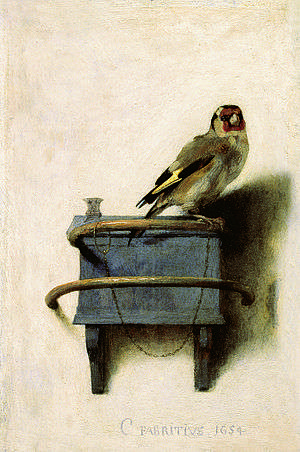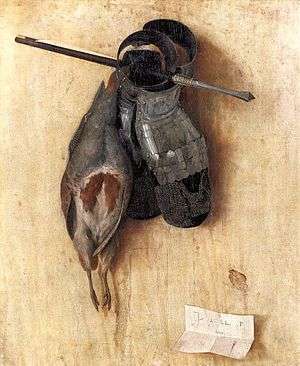The Goldfinch (painting)
| Dutch: Het puttertje | |
 | |
| Artist | Carel Fabritius |
|---|---|
| Year | 1654 |
| Type | Animal painting |
| Material | Oil on panel |
| Subject | European goldfinch |
| Dimensions | 33.5 cm × 22.8 cm (13.2 in × 9.0 in) |
| Location | Mauritshuis, The Hague, Netherlands |
The Goldfinch (Dutch: Het puttertje) is a 1654 animal painting by Carel Fabritius of a chained goldfinch. It is an oil painting on panel of 33.5 by 22.8 cm (13.2 by 9.0 in). The work is in the collection of the Mauritshuis in The Hague, Netherlands.[1]
Subject
The painting is a trompe-l'œil[2] of a European goldfinch (Carduelis carduelis) on top of its feeder that is attached to the wall. The feeder consists of two half rings and a blue container. The bird is sitting on the top ring, to which it is chained by its foot.[3] The painting is signed "C fabritivs 1654" at the bottom.[4]
In the 17th century, goldfinches were popular pets because they could be trained to draw water from a bowl with a miniature bucket.[3] The Dutch title of the painting pertains to the bird's nickname puttertje, which refers to this custom and translates literally as 'little weller'.[5]
Style
The work was painted without major corrections, with only minor ones to the contours of the bird. Most of the painting is set up with large brush strokes, but details such as the chain are painted with more precision. Fabritius showed off his skill by painting the bird's head foreshortened.[2]
It is one of three paintings that Fabritius painted in the year that he died. It is painted in a style distinct from Fabritius' master Rembrandt. In style, the work is closer to Fabritius' supposed pupil Johannes Vermeer, who further improved the skill of painting shadows.[2] Though art historians have found no hard evidence to support this master-pupil relationship.[Montias 1]

As a trompe-l'œil, it is a unique work in Dutch Golden Age painting. It has been compared with Still-Life with Partridge and Gauntlets (1540) that Jacopo de' Barbari painted more than 100 years earlier.[2]
Ownership
The Goldfinch was owned by Chevalier Joseph-Guillaume-Jean Camberlyn in Brussels, when it was given to Etienne-Joseph-Théophile Thoré in 1865. It was sold again at Hôtel Drouot in Paris on 5 December 1892. The painting was later purchased by Abraham Bredius for the Mauritshuis[6] at the sale of the E. Martinet collection also at Hôtel Drouot on 27 February 1896.[4] The painting is in the permanent collection of the Mauritshuis in The Hague and currently on display in the museum.[7]
Cultural legacy
The painting plays a central role in the Pulitzer Prize-winning novel The Goldfinch (2013) written by Donna Tartt.[8]
References
- ↑ (Dutch) "Het puttertje", Geheugen van Nederland, National Library of the Netherlands. Retrieved on 15 August 2014.
- 1 2 3 4 (Dutch) W. Martin, De Hollandsche schilderkunst in de zeventiende eeuw: Rembrandt en zijn tijd, 1936. Retrieved on 15 August 2014.
- 1 2 The Goldfinch, Mauritshuis. Retrieved on 15 August 2014.
- 1 2 Details: Carel Fabritius, The Goldfinch, 1654, Mauritshuis. Retrieved on 15 August 2014.
- ↑ (Dutch) Het puttertje, Mauritshuis. Retrieved on 15 August 2014.
- ↑ Peeters, Carel (24 July 2015). "De gekooide, vrije vogel van Fabritius". Vrij Nederland (in Dutch).
- ↑ Masterpieces from the Mauritshuis, Mauritshuis. Retrieved on 15 August 2014.
- ↑ Maddie Crum, "Pulitzer Prize For Fiction 2014: Donna Tartt's 'The Goldfinch' Wins", The Huffington Post, 2014. Retrieved on 15 August 2014.
Sources
- Montias, John Michael (1991). Vermeer and His Milieu: A Web of Social History (reprint, illustrated ed.). Princeton University Press. ISBN 978-0-691-00289-7.
- ↑ p. 104.
External links
| Wikimedia Commons has media related to The Goldfinch. |
- The Goldfinch at the Mauritshuis website
| ||||||||||||||